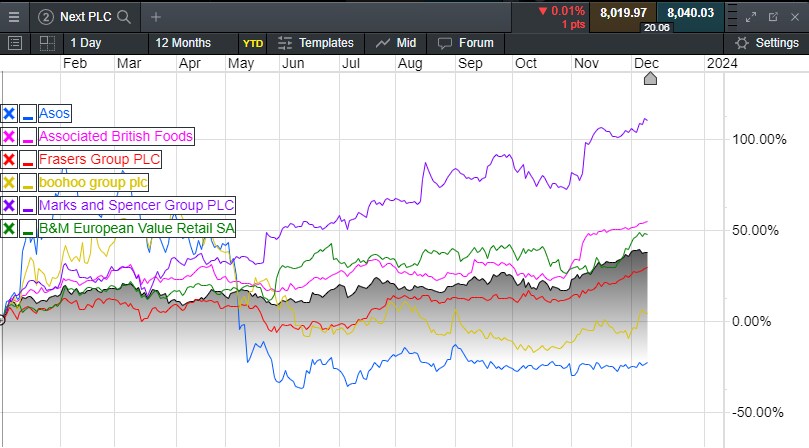The UK retail sector has faced plenty of challenges over the last few years navigating the lockdowns of the Covid pandemic only to be hammered by the impact of Russia’s invasion of Ukraine as the costs of carrying out business soared.
In 2022 we saw big share price falls in the likes of Next, which slipped to 30-month lows, along with Marks & Spencer, while Primark owner Associated British Foods saw its share price fall to its lowest level since 2012, after headline inflation peaked at a 40-year high of 11.1%.
These lows proved to be a significant turning point as pessimism around the UK consumer was at its peak, with consumer confidence close to record lows of -49.
At the time the Bank of England was also predicting that the UK was on the cusp of a 2-year recession, as consumers faced a perfect storm of sharply rising rates and an energy price cap that had seen a big rise from the previous cap.
Since those series of low points in October 2022 the picture for the UK retail sector has improved quite considerably even allowing for the fact that this year, we’ve seen a few notable retail collapses.
According to the Centre of Retail Research 62 UK retailers have gone into administration, up from 49 in 2022, the most notable of which was Wilko which saw some of its stores taken over by B&M European Retail, along with Edinburgh Woollen Mill, M&Co, and the Dorothy Perkins brand.
Despite this increasing failure rate, the wider sector has been able to adapt the challenging economic outlook, with the most notable outperformers being the established high street names at the expense of the online retailers which have seen a significant deterioration in their share price performance.
UK retail sector YTD

Source: CMC Markets
As can be seen from the above graphic, the likes of boohoo group and ASOS have continued to struggle with Boohoo shares sinking to their lowest levels since 2016, and ASOS sinking to their lowest levels since 2010.
Superdry has also had a poor year its shares sinking to record lows earlier this week, with the retailer blaming the unseasonal weather. This has been a familiar refrain from a lot of retailers.
While blaming the weather is a perfectly legitimate excuse along with a difficult retail environment it’s also notable that this year, we’ve seen solid retail updates from the likes of Next, Primark, M&S and JD Sports, which would perhaps suggest that Superdry’s problems lie a little closer to home, and that customers simply don’t want to buy their products.
The rest of the sector and the FTSE 350 General Retail Index has pushed up to its best level since early 2022, led by the likes of Next, Primark owner Associated British Foods, Marks and Spencer and B&M European Retail, all of whom are amongst the top 20 best performing FTSE100 stocks year to date.
Marks and Spencer have been the best performer, up 100% year to date, the shares retesting their 2022 peaks, as the turnaround plan set in motion by previous CEO Steve Rowe has gone from strength to strength under new CEO Stuart Machin, with the retailer announcing the restoration of the dividend.
H1 profits before tax rose 56.2% to £325.6m on the back of a 10.8% rise in statutory revenue to £6.13bn. Management also managed to reduce net debt by £370m as well as returning to a positive cash flow situation.
On the actual sales numbers themselves, food retail was once again a standout performer, with 11.7% increase in like for like sales, along with an improvement in operating margin, while in general merchandising like for like sales rose 5.5%.
October trading momentum has been positive according to management, although M&S did express caution over the second half of the year given the combined impact of a higher interest rates environment, as well as concerns about a slowing economy, and deflationary forces impacting consumer sentiment, along with an uncertain geopolitical outlook.
Primark owner Associated British Foods also put a disappointing 2022 behind it with a similarly upbeat set of trading numbers back in November.
Full year revenues saw an increase of 16% to £19.75bn, with the Primark business accounting for £9bn of that rising by 17%, although adjusted operating margins fell to 8.2% from 9.8%. Higher sugar prices helped to boost revenues in the sugar business by 26% to £2.55bn, however higher energy costs saw margins narrow to 6.6%.
The grocery business was one of two areas that ABF managed to maintain its adjusted operating margins. These held steady at 10.7%, as revenue rose 12% to £4.2bn.
The ingredients business saw operating margins increase to 9.9%, as revenues increased to £2.15bn, helped by a strong performance from its yeast and bakery division.
On the outlook ABF said they expected operating margins in the Primark business for 2024 to improve to above 10% as inflation pressures ease. The retailer also announced another £500bn share buyback as well as a special dividend of 12.7p per share, with the shares rising to their highest levels in over 2 years.
NextPLC has also had a strong year, raising its full year profits guidance for the fourth time this year back in November, after announcing a 4% increase in Q3 full price sales, and raising its profit before tax to £885m from £875m, while also upgrading its full year sales guidance to an increase of 3.1%.
Last but by no means least, B&M European Retail, which acquired several of the old Wilko stores has also had a solid year, reporting a 10.4% increase in half year revenues to £2.55bn.
Having undergone such a challenging 2023 the bigger question is whether the outperformance seen during the past 12 months can be sustained into 2024, and on that the jury is out. What we do know is that since their post lockdown peaks Boohoo and ASOS have seen their share prices obliterated, as the business model which prospered during Covid has been found wanting.
The more traditional retailers have been able to adapt their business models, and while they have faced challenges, with 2022 being particularly challenging, have been able to hold onto those gains and in the cases of Frasers Group, B&M European Retail and Marks and Spencer enhance it.
As for the supermarkets and food retail it’s been equally competitive with Aldi and Lidl continuing to gain market share at the expense of their bigger peers, while Marks & Spencer has also established itself as a major player at the expense of the likes of Waitrose in its food business.
Despite this increasing competition Sainsbury has managed to establish itself as the nearest competitor to Tesco’s position as the UK’s number one grocery retailer, with both supermarkets managing to see solid share price gains so far year to date
Sainsbury and Tesco share price performance YTD

Source: CMC Markets
At their most recent set of numbers Sainsbury upgraded their full year profits guidance to between £670m and £700m, with retail free cash flow upgraded from £500m to £600m, after reporting H1 like for like sales of 8.4% with Q2 seeing an increase of 6.6%.
Grocery sales were particularly strong, rising 10.1%, while its Argos business saw general merchandise sales rise by 1.7%, which was a welcome surprise given that in the lead-up to today’s numbers this was an area that was identified as a possible weak spot. H1 group revenue excl VAT came in at £16.98bn a rise of 3.5%.
Underlying H1 profits before tax came in at £340m, the same as last year, although underlying earnings per share were down 6% due to the higher rate of corporation tax. The dividend was kept unchanged at 3.9p per share.
Actual profits after tax came in at £155m, a decline of 46%.
Earlier this month Kantar reported that UK supermarket sales had continued to remain strong with sales growth of 6.3%, for the 12-weeks to 26th November.
Aldi was the big winner with sales of 11.1%, however Sainsbury’s also performed strongly over the quarter with 10.2% sales growth, increasing its market share to 15.6%, while Tesco saw sales growth of 8.6%. Grocery inflation slowed to 9.1% for the 4-weeks to the end of November, from 9.7%.
Tesco shares have also performed well year to date as they also lifted guidance back in October, raising their expectations for full year profit to between £2.6bn and £2.7bn while expecting to generate retail FCF of between £1.8bn and £2bn, up from their previous estimate of between £1.4bn and £1.8bn.
The UK’s number 1 supermarket reported an 8.9% increase in total group sales to £30.75bn, and a 14% rise in adjusted operating profit of £1.48bn, comfortably beating forecasts of £1.42bn.
Statutory profits for H1 after tax rose to £929m, a decent increase on last year’s £252m, though this was impacted by a -£579m impairment charge which dragged the H1 number lower.
The increase in profits has been driven by a laser-like focus on costs with the supermarket saying it remains on target to cut £600m of costs by year end.
All areas of the business appear to be performing well, with the UK and Ireland business leading the way with an 8.4% increase in like for like sales.
The Booker business also performed well with a 7.5% increase in sales to £4.7bn, with the only laggard being the Central European business which saw a 0.9% gain in like for like sales.
The improvement has been driven predominantly by the grocery business which saw a 10.6% increase while clothing sales fell by -4.8%, with Tesco saying that they had improved their market share by 30bps to 27.2%, with the online business also performing well, with a 10% rise in sales which rose to £3bn.
Both supermarkets said that inflation pressures were easing and that they expect that trend to continue in the coming months, although according to Kantar it is still running at over 9%.
To conclude the economic outlook for 2024 remains very uncertain with various economic forecasters predicting an immensely challenging economic outlook with the likes of Bank of England predicting no growth at all during 2024.
There are reasons to be optimistic however with inflation slowing sharply, we could start to see rate cuts by the middle of next year which could ease some of the pressure on household finances, and mortgage rates especially.
Disclaimer: CMC Markets is an execution-only service provider. The material (whether or not it states any opinions) is for general information purposes only, and does not take into account your personal circumstances or objectives. Nothing in this material is (or should be considered to be) financial, investment or other advice on which reliance should be placed. No opinion given in the material constitutes a recommendation by CMC Markets or the author that any particular investment, security, transaction or investment strategy is suitable for any specific person. The material has not been prepared in accordance with legal requirements designed to promote the independence of investment research. Although we are not specifically prevented from dealing before providing this material, we do not seek to take advantage of the material prior to its dissemination.





